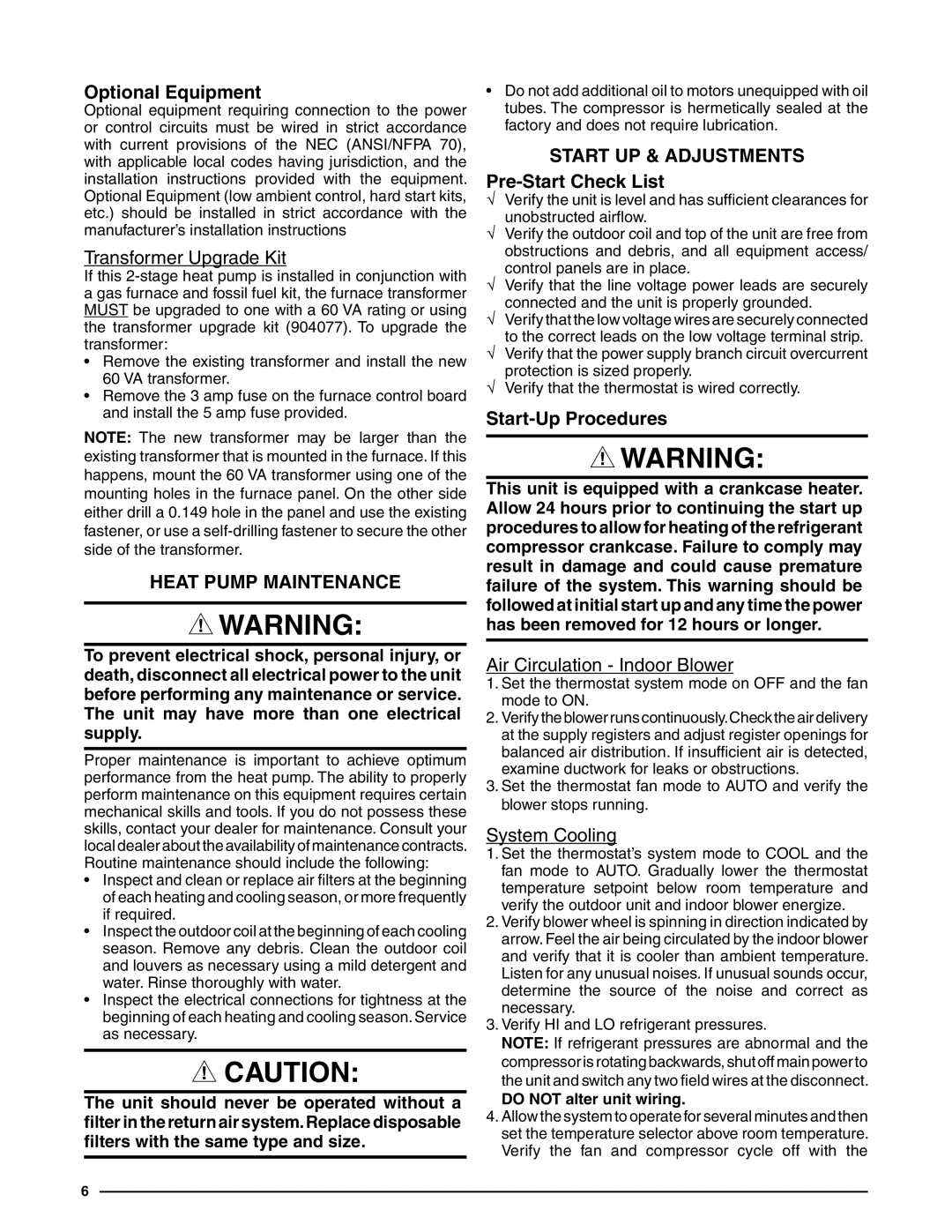Optional Equipment
Optional equipment requiring connection to the power or control circuits must be wired in strict accordance with current provisions of the NEC (ANSI/NFPA 70), with applicable local codes having jurisdiction, and the installation instructions provided with the equipment. Optional Equipment (low ambient control, hard start kits, etc.) should be installed in strict accordance with the manufacturer’s installation instructions
Transformer Upgrade Kit
If this 2-stage heat pump is installed in conjunction with a gas furnace and fossil fuel kit, the furnace transformer MUST be upgraded to one with a 60 VA rating or using the transformer upgrade kit (904077). To upgrade the transformer:
•Remove the existing transformer and install the new
60 VA transformer.
•Remove the 3 amp fuse on the furnace control board and install the 5 amp fuse provided.
NOTE: The new transformer may be larger than the existing transformer that is mounted in the furnace. If this happens, mount the 60 VA transformer using one of the mounting holes in the furnace panel. On the other side either drill a 0.149 hole in the panel and use the existing fastener, or use a self-drilling fastener to secure the other side of the transformer.
HEAT PUMP MAINTENANCE
 WARNING:
WARNING:
To prevent electrical shock, personal injury, or death, disconnect all electrical power to the unit before performing any maintenance or service. The unit may have more than one electrical supply.
Proper maintenance is important to achieve optimum performance from the heat pump. The ability to properly perform maintenance on this equipment requires certain mechanical skills and tools. If you do not possess these skills, contact your dealer for maintenance. Consult your local dealer about the availability of maintenance contracts. Routine maintenance should include the following:
•Inspect and clean or replace air filters at the beginning of each heating and cooling season, or more frequently if required.
•Inspect the outdoor coil at the beginning of each cooling season. Remove any debris. Clean the outdoor coil and louvers as necessary using a mild detergent and water. Rinse thoroughly with water.
•Inspect the electrical connections for tightness at the beginning of each heating and cooling season.Service as necessary.
 CAUTION:
CAUTION:
The unit should never be operated without a filter in the return air system.Replace disposable filters with the same type and size.
•Do not add additional oil to motors unequipped with oil tubes. The compressor is hermetically sealed at the factory and does not require lubrication.
START UP & ADJUSTMENTS Pre-Start Check List
√Verify the unit is level and has sufficient clearances for unobstructed airflow.
√Verify the outdoor coil and top of the unit are free from obstructions and debris, and all equipment access/ control panels are in place.
√Verify that the line voltage power leads are securely connected and the unit is properly grounded.
√Verify that the low voltage wires are securely connected to the correct leads on the low voltage terminal strip.
√Verify that the power supply branch circuit overcurrent protection is sized properly.
√Verify that the thermostat is wired correctly.
Start-Up Procedures
 WARNING:
WARNING:
This unit is equipped with a crankcase heater. Allow 24 hours prior to continuing the start up procedures to allow for heating of the refrigerant compressor crankcase. Failure to comply may result in damage and could cause premature failure of the system. This warning should be followed at initial start up and any time the power has been removed for 12 hours or longer.
Air Circulation - Indoor Blower
1.Set the thermostat system mode on OFF and the fan mode to ON.
2.Verify the blower runs continuously.Check the air delivery at the supply registers and adjust register openings for balanced air distribution. If insufficient air is detected, examine ductwork for leaks or obstructions.
3.Set the thermostat fan mode to AUTO and verify the blower stops running.
System Cooling
1.Set the thermostat’s system mode to COOL and the fan mode to AUTO. Gradually lower the thermostat temperature setpoint below room temperature and verify the outdoor unit and indoor blower energize.
2.Verify blower wheel is spinning in direction indicated by arrow. Feel the air being circulated by the indoor blower and verify that it is cooler than ambient temperature. Listen for any unusual noises. If unusual sounds occur, determine the source of the noise and correct as necessary.
3.Verify HI and LO refrigerant pressures.
NOTE: If refrigerant pressures are abnormal and the compressor is rotating backwards, shut off main power to the unit and switch any two field wires at the disconnect.
DO NOT alter unit wiring.
4.Allow the system to operate for several minutes and then set the temperature selector above room temperature. Verify the fan and compressor cycle off with the

